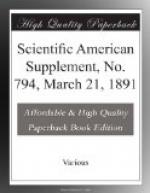The next change demanded is smokelessness, and to accomplish it recourse is had to the high explosive field, mechanically mixing various substances with them to reduce and regulate their rapidity of action. Just now some form of gun-cotton is most in use mixed with nitrate of ammonia, camphor and other articles. The tendency of these mixtures is to absorb moisture, and the gun-cotton in them to decompose, and there is no smokeless powder which can to-day be considered successful. Such a powder, however, will undoubtedly be an accomplished fact in the near future. Military men seem to be a great deal at variance as to its value in the field, but there can be no doubt of its value for naval purposes; it is a necessity forced upon us by the development of torpedo warfare.
First came the simple torpedo, at the end of an ordinary boat’s spar. Then came the special torpedo boat with its great speed, then the revolving cannon and rapid-fire gun to meet the torpedo boat. At present the possible rapidity of fire is much greater than can be utilized, on account of the smoke; hence the necessity of smokeless powder. Smokelessness is, however, principally a martial demand that has been made upon the science of explosives and has attracted public attention on that account. The commercial demands for various other properties have been much greater than the military, and between gunpowder near one end of the line in point of power and nitro-glycerine near the other, there are now over 350 different explosives manufactured, and most of these have been invented within the last twenty years.
The simplest application of high explosives in warfare is in connection with torpedoes, since within the same bulk a much more efficient substance can be obtained than gunpowder, and with reasonable care there is very little danger of premature explosions by reason of accidental shocks.
Torpedoes were made by the Chinese many years ago, they were tried in our war of independence, and also by the Russians during the Crimean war; but the first practical and successful use of them as a recognized weapon was during our war of secession, when thirty-seven vessels were either sunk or seriously injured by them. Gunpowder was used in these torpedoes, though it is stated that attempts were made to use other substances without success. Since that time all maritime nations have made a close study of the subject and have adopted various high explosives, according to the results of their experiments. In general terms it may be stated that explosive chemical compounds have been found more suitable than explosive mixtures, because of the uniformity of direction in which they exert their pressure, and from the fact that water does not injure them. Mixtures may be very powerful, but they are erratic and require tight cases. In the United States we use dynamite for harbor mines. It is composed of seventy-five per cent. nitro-glycerine and twenty-five per cent. silica; but blasting gelatine and forcite gelatine will probably be adopted, when they can be satisfactorily manufactured here, as they are more powerful. The former is composed of ninety-two per cent. of nitro-glycerine and eight per cent. of gun-cotton, and the latter of ninety-five per cent. of nitro-gelatine and five per cent. unnitrated cellulose.




